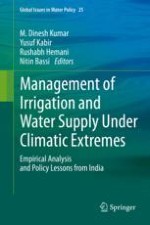2021 | OriginalPaper | Buchkapitel
7. A Framework for Assessing Climate-Induced Risk for Water Supply, Sanitation and Hygiene
verfasst von : M. Dinesh Kumar, Arijit Ganguly, Yusuf Kabir, Omkar Khare
Erschienen in: Management of Irrigation and Water Supply Under Climatic Extremes
Aktivieren Sie unsere intelligente Suche, um passende Fachinhalte oder Patente zu finden.
Wählen Sie Textabschnitte aus um mit Künstlicher Intelligenz passenden Patente zu finden. powered by
Markieren Sie Textabschnitte, um KI-gestützt weitere passende Inhalte zu finden. powered by
